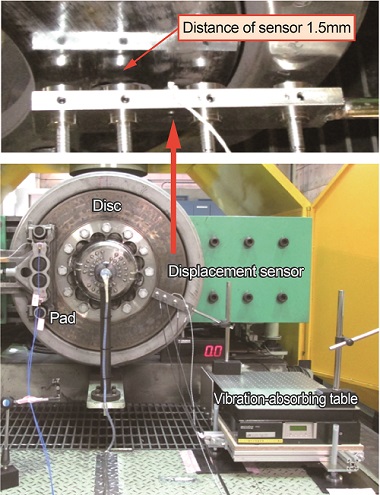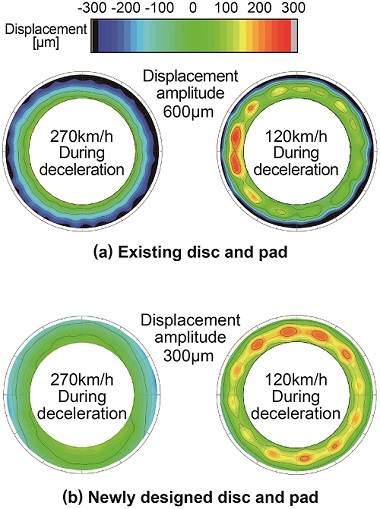25. Method for measuring dynamic deformation of brake disc
The high speed vehicles that are the trademark of Shinkansen lines use disc braking. This type of braking method involves the brake pad being pressed onto the brake disc generating frictional force. Consequently, the faster the speed, the greater the heat produced by this rubbing, which in some cases leads to lower braking performance. Observations made of the disc in this mechanism using a thermal-camera show that the spots where heat is generated constantly vary over time. However, there is no insight, including from other industries, about the mechanisms underlying the dynamic deformation of discs, which is another factor thought to contribute to lower performance. This lack of knowledge is one of the obstacles to making progress in brake device assembly research and development (discs, pads, calipers).
The method described here was therefore proposed to measure the dynamic deformation of the brake disc in operation using a vibration-absorbing table and electrostatic capacitance type sensors capable of measuring displacement without contact (Fig. 1).
Through in-depth dynamic deformation analysis of the disc in operation from different rotation angles, it is possible to visualize dynamic deformation (Fig. 2). Through these investigations, it was possible to clarify: the cyclic appearance of deformation on the friction surface, the differing aspects of dynamic deformation depending on the disc/pad configuration and microscopic deformation related to the distance between disc lock (fastening) bolts.
The proposed measurement method will be useful not only for design verification of the shape and mechanical structure of brake pads and discs, but may also contribute to clarifying frictional mechanisms and evaluating braking noise.
Other Contents
- 25. Method for measuring dynamic deformation of brake disc
- 26. Current collection HILS system enabling simulated running tests
- 27. Reproduction of meandering airflows under the carbody through numerical simulation
- 28. Wind tunnel tests reproducing the wind force resulting from natural wind and vehicle velocity to evaluate aerodynamic forces acting on railway vehicles
- 29. Wind tunnel tests for detailed detection of sources of aerodynamic noise from bogies
- 30. Assessment of driver state based on physiological indices
- 31. Multi-segment pantograph head with high compliance to contact wire fluctuation
- 25. Method for measuring dynamic deformation of brake disc
- 26. Current collection HILS system enabling simulated running tests
- 27. Reproduction of meandering airflows under the carbody through numerical simulation
- 28. Wind tunnel tests reproducing the wind force resulting from natural wind and vehicle velocity to evaluate aerodynamic forces acting on railway vehicles
- 29. Wind tunnel tests for detailed detection of sources of aerodynamic noise from bogies
- 30. Assessment of driver state based on physiological indices
- 31. Multi-segment pantograph head with high compliance to contact wire fluctuation


